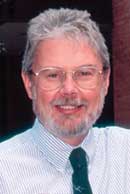by Lee Allison,
Director and State Geologist

Kansas is leading the region in many ways to better manage and preserve our ground-water resources. For the KGS, this is one of our most important missions
The
High Plains aquifer is the most important ground-water source
for an eight-state region in the Midwest and Rocky Mountains. Rather than
a single aquifer, the High Plains is actually a set of aquifers including
the Ogallala and other surficial units. The High Plains aquifer is the
primary source of water for irrigation in western Kansas. But in some
areas, the water table is dropping to its economic limit. Unless irrigation
practices or volumes pumped change significantly, more areas may have
to revert to dryland farming within as little as 25 years.
The newly published “Atlas of the High Plains Aquifer” (KGS
Educational Series 14) summarizes decades of ground-water data into a
series of maps that paint the clearest picture ever of this critically
important underground geologic reservoir. An electronic version of the
Atlas has been available on the KGS web site for many months (http://www.kgs.ku.edu),
but the printed version was released only in late December 2000. It took
three years to produce with funding from the Kansas Water Plan. Co-editors
Jeff Schloss and Bob Buddemeier of the KGS and Blake Wilson of the Kansas
Water Office worked closely with state and local water agencies to ensure
that the Atlas presents the most relevant data in formats that will be
easily understood by water users and planners. The Atlas is one of the
most important publications ever produced by the KGS.
KGS’s involvement in producing the Atlas is just one of many efforts
underway on the High Plains aquifer. This past summer, we took the lead
in organizing the geological surveys of the eight states and the U.S.
Geological Survey into a coalition to coordinate and promote better scientific,
comprehensive understanding of the aquifer. The High Plains Aquifer Coalition
intends to share data, techniques, talent, and ideas. We propose that
each state survey serve as an information portal to all the state entities
that have data on the High Plains aquifer. We want all data in digital
formats and available through the internet. We want software tools that
will allow visitors to the web site to create individualized or specialized
maps, analyses, and models using data from wherever it is stored in a
distributed digital geolibrary system.
A source of potential funding is legislation proposed to the U.S. Senate
last fall. The Kansas Water Authority (KWA) reviewed a bill by Senator
Jeff Bingaman of New Mexico that proposed investing $70 million per year
for 20 years into efforts to make the southern part of the High Plains
aquifer sustainable. KWA’s analysis determined that the proposal
should cover the entire eight-state region and would require $250 million
per year to fully implement. They identified state surveys as the appropriate
agencies to coordinate the scientific component of the program. A question
for the upcoming session of Congress is whether the Kansas concept and
the Bingaman bill go forward as separate efforts or as an integrated plan.
In an independent initiative, the Ogallala Aquifer Institute (OAI) was
recently established in Garden City, Kansas, to carry out an educational
mission throughout the eight-state region. There is a natural basis for
cooperation and partnership between the Coalition and OAI. Scientific
studies of the aquifer by themselves do no good. The results of research
need to be disseminated, explained in a commonsense way, and then appropriately
implemented to make policy and management decisions.
Kansas is leading the region in many ways to better manage and preserve our ground-water resources. For the KGS, this is one of our most important missions.
![]()
Kansas Earth Science Teacher of the Year
Bill Dymacek, earth science teacher
at Nike Middle School in Gardner, has received the 2000–2001 Excellence
in Kansas Earth Science Education Award from the Kansas Geological Foundation
and the Kansas Earth Science Teachers Association. This award of $1,000,
funded by the Kansas Geological Foundation, is given to an outstanding
earth science teacher in grades K–12. The award was presented in
December at the Kansas Geological Foundation’s annual meeting in
Wichita. Finalist for the award was Lois Eppich of Saints Peter and Paul
School, Seneca, who received a gift certificate for publications from
the Kansas Geological Survey.
Dymacek is the eighth recipient of the Excellence in Kansas Earth Science Education Award. The 1999–2000 winner was Angela Epps, from California Trails Junior High School in Olathe.
Online February 10, 2003
Comments to: lbrosius@kgs.ku.edu
Kansas Geological Survey
URL:http://www.kgs.ku.edu/Publications/GeoRecord/2001/vol7.1/Page2.html